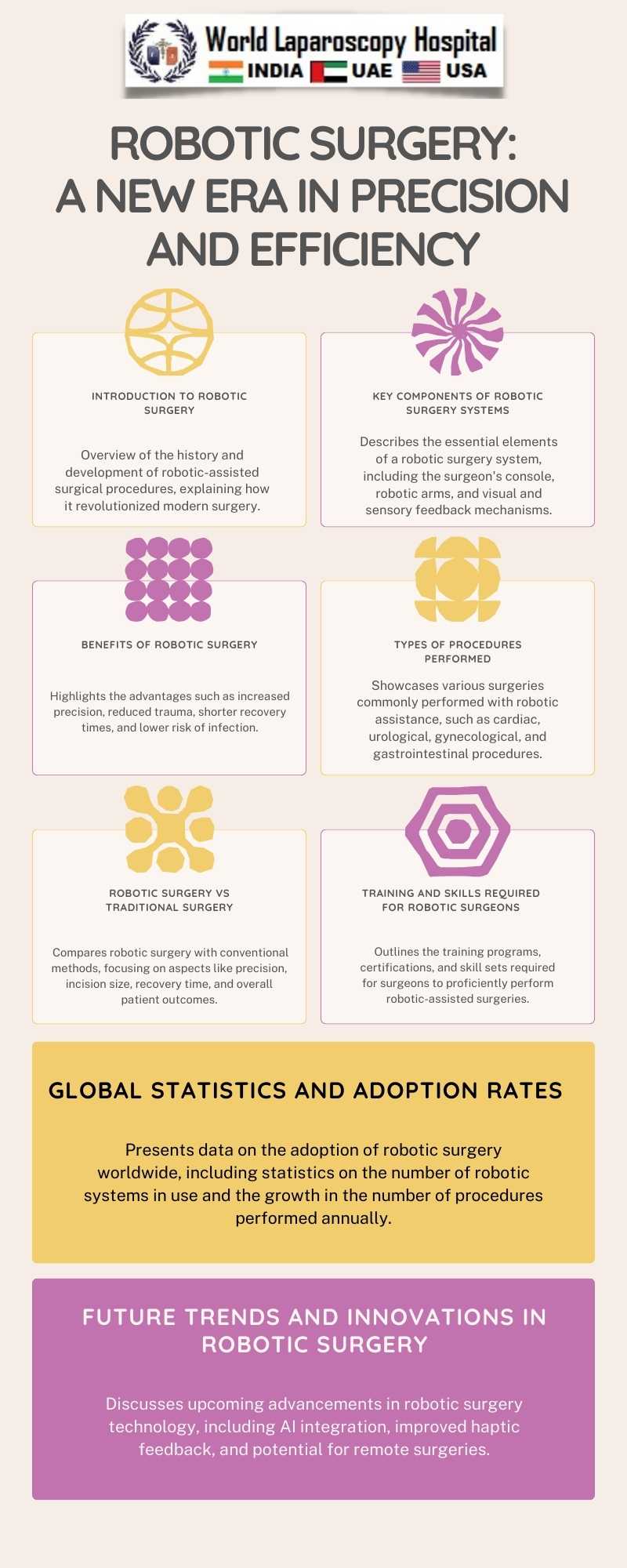Robotic Surgery: A New Era in Precision and Efficiency
Robotic Surgery: A New Era in Precision and Efficiency
Introduction
The advent of robotic surgery marks a significant leap in medical technology, heralding a new era of precision and efficiency in surgical procedures. This essay explores the evolution, benefits, challenges, and future implications of robotic surgery, a domain where machines and human skills converge to enhance patient care.

Evolution of Robotic Surgery
Robotic surgery, a concept that once belonged to the realms of science fiction, has become a reality in the 21st century. Its roots can be traced back to the late 20th century, with the development of early robotic systems designed to assist in minimally invasive procedures. The FDA's approval of the da Vinci Surgical System in 2000 marked a watershed moment, signaling the official entry of robotic assistance into operating theatres.
Benefits of Robotic Surgery
The primary benefits of robotic surgery are precision, minimization of invasiveness, and enhanced dexterity. Robotic systems offer high-definition, 3D visualization of the surgical field, surpassing the limitations of the human hand and eye. This leads to greater accuracy in procedures, potentially reducing the risks associated with traditional surgery. Moreover, patients often experience reduced post-operative pain, quicker recovery, and lesser scarring, contributing to improved overall outcomes.
Robotic Surgery in Practice
In practice, robotic surgery finds applications in a wide array of medical fields, including but not limited to urology, gynecology, and cardiothoracic surgery. Surgeons control robotic arms from a console, executing intricate procedures with greater control than conventional methods allow. The technology has been particularly transformative in procedures like prostatectomies and hysterectomies, where precision is paramount.
Challenges and Considerations
Despite its advantages, robotic surgery faces several challenges. The high cost of acquiring and maintaining robotic systems is a significant barrier, limiting accessibility to well-funded healthcare facilities. There is also a steep learning curve for surgeons adapting to this new technology. Moreover, concerns regarding over-reliance on technology and potential technical failures necessitate stringent safety protocols and contingency plans.
The Future of Robotic Surgery
The future of robotic surgery is bright and replete with possibilities. Advancements in artificial intelligence and machine learning are expected to further enhance the capabilities of robotic systems, possibly leading to greater autonomy in surgical procedures. Tele-surgery, where surgeons operate remotely, could revolutionize medical care in remote or underserved regions.
Conclusion
Robotic surgery represents a remarkable fusion of technology and human skill, offering unprecedented precision and efficiency in surgical procedures. While challenges remain, its continued evolution and integration into healthcare promise to reshape the landscape of surgery, making complex procedures safer and more accessible. As this technology advances, it holds the potential to significantly improve patient outcomes and redefine surgical standards worldwide.
Introduction
The advent of robotic surgery marks a significant leap in medical technology, heralding a new era of precision and efficiency in surgical procedures. This essay explores the evolution, benefits, challenges, and future implications of robotic surgery, a domain where machines and human skills converge to enhance patient care.

Evolution of Robotic Surgery
Robotic surgery, a concept that once belonged to the realms of science fiction, has become a reality in the 21st century. Its roots can be traced back to the late 20th century, with the development of early robotic systems designed to assist in minimally invasive procedures. The FDA's approval of the da Vinci Surgical System in 2000 marked a watershed moment, signaling the official entry of robotic assistance into operating theatres.
Benefits of Robotic Surgery
The primary benefits of robotic surgery are precision, minimization of invasiveness, and enhanced dexterity. Robotic systems offer high-definition, 3D visualization of the surgical field, surpassing the limitations of the human hand and eye. This leads to greater accuracy in procedures, potentially reducing the risks associated with traditional surgery. Moreover, patients often experience reduced post-operative pain, quicker recovery, and lesser scarring, contributing to improved overall outcomes.
Robotic Surgery in Practice
In practice, robotic surgery finds applications in a wide array of medical fields, including but not limited to urology, gynecology, and cardiothoracic surgery. Surgeons control robotic arms from a console, executing intricate procedures with greater control than conventional methods allow. The technology has been particularly transformative in procedures like prostatectomies and hysterectomies, where precision is paramount.
Challenges and Considerations
Despite its advantages, robotic surgery faces several challenges. The high cost of acquiring and maintaining robotic systems is a significant barrier, limiting accessibility to well-funded healthcare facilities. There is also a steep learning curve for surgeons adapting to this new technology. Moreover, concerns regarding over-reliance on technology and potential technical failures necessitate stringent safety protocols and contingency plans.
The Future of Robotic Surgery
The future of robotic surgery is bright and replete with possibilities. Advancements in artificial intelligence and machine learning are expected to further enhance the capabilities of robotic systems, possibly leading to greater autonomy in surgical procedures. Tele-surgery, where surgeons operate remotely, could revolutionize medical care in remote or underserved regions.
Conclusion
Robotic surgery represents a remarkable fusion of technology and human skill, offering unprecedented precision and efficiency in surgical procedures. While challenges remain, its continued evolution and integration into healthcare promise to reshape the landscape of surgery, making complex procedures safer and more accessible. As this technology advances, it holds the potential to significantly improve patient outcomes and redefine surgical standards worldwide.
1 COMMENTS
Dr. Akash Bhattacharya
#1
Jan 27th, 2024 11:10 am
Robotic surgery combines technology and human skill for remarkable precision and efficiency in procedures. Challenges persist, but ongoing evolution promises to reshape surgery, enhancing safety and accessibility. Advancing technology holds the potential to significantly improve global surgical standards and patient outcomes.
| Older Post | Home | Newer Post |


